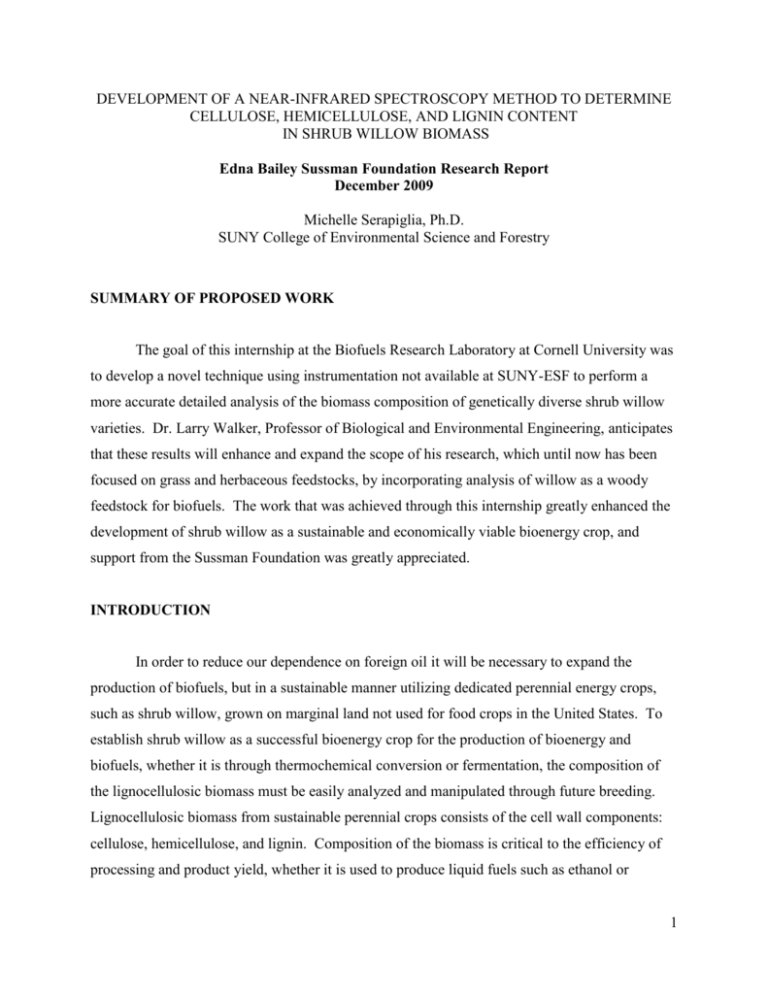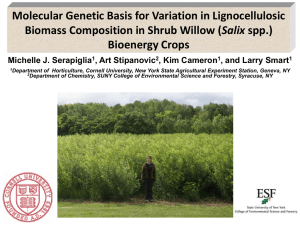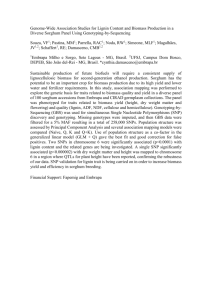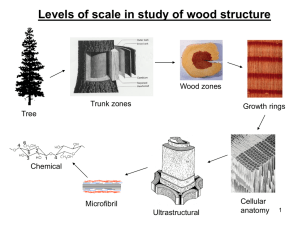Development of a Near-Infrared Spectroscopy Method to Determine
advertisement

DEVELOPMENT OF A NEAR-INFRARED SPECTROSCOPY METHOD TO DETERMINE CELLULOSE, HEMICELLULOSE, AND LIGNIN CONTENT IN SHRUB WILLOW BIOMASS Edna Bailey Sussman Foundation Research Report December 2009 Michelle Serapiglia, Ph.D. SUNY College of Environmental Science and Forestry SUMMARY OF PROPOSED WORK The goal of this internship at the Biofuels Research Laboratory at Cornell University was to develop a novel technique using instrumentation not available at SUNY-ESF to perform a more accurate detailed analysis of the biomass composition of genetically diverse shrub willow varieties. Dr. Larry Walker, Professor of Biological and Environmental Engineering, anticipates that these results will enhance and expand the scope of his research, which until now has been focused on grass and herbaceous feedstocks, by incorporating analysis of willow as a woody feedstock for biofuels. The work that was achieved through this internship greatly enhanced the development of shrub willow as a sustainable and economically viable bioenergy crop, and support from the Sussman Foundation was greatly appreciated. INTRODUCTION In order to reduce our dependence on foreign oil it will be necessary to expand the production of biofuels, but in a sustainable manner utilizing dedicated perennial energy crops, such as shrub willow, grown on marginal land not used for food crops in the United States. To establish shrub willow as a successful bioenergy crop for the production of bioenergy and biofuels, whether it is through thermochemical conversion or fermentation, the composition of the lignocellulosic biomass must be easily analyzed and manipulated through future breeding. Lignocellulosic biomass from sustainable perennial crops consists of the cell wall components: cellulose, hemicellulose, and lignin. Composition of the biomass is critical to the efficiency of processing and product yield, whether it is used to produce liquid fuels such as ethanol or 1 polymers such as biodegradable plastics. Selection based on biomass composition would allow development of new shrub willow varieties with ideal biomass properties for conversion to bioenergy and biofuels; although, further research is needed to determine the genetic basis for and heritability of biomass composition characteristics and thus the potential for manipulation through breeding and selection. Ideal biomass composition will depend on the conversion process specific willow varieties will be marketed for. High-resolution thermogravimetric analysis (HR-TGA) has been established as a method to identify shrub willow varieties with ideal biomass properties for the environmentally sustainable production of biofuels and bioproducts. An HR-TGA method has been optimized and proven to be a strong analytical method for shrub willow biomass composition determination, but one of its disadvantages is the time required to process and analyze each sample. Since each sample requires 90 min of instrument time, high-throughput processing of hundreds of samples would require multiple instruments. Even though HR-TGA can analyze samples at a significantly higher rate than can be accomplished using wet chemical analysis, near-infrared (NIR) spectroscopy provides an opportunity to analyze many more samples since each sample requires only a few seconds of instrument time. NIR spectroscopy has multiple advantages as a method for the analysis of biomass including: nondestructive measurement, ability to process large numbers of samples in a short period of time, collection of detailed information for each sample, and compatibility with a wide range of organic materials. The NIR spectroscopy includes the spectral range, 14290-4000 cm-1, and absorption bands observed in this region result from overtones of fundamental vibrational bands that occur in the mid-infrared. Interpretation of NIR spectra is rather complicated due to the overlapping of overtones and combinations of vibrations. Development of models to predict certain variables and evaluation of the spectra requires chemometrics, a form of multivariate analysis. Through calibration and prediction, spectral analysis software can be trained to convert NIR spectral measurements into relevant information about the samples analyzed and the quantitative or qualitative variable of interest. The focus of this study was to develop a NIR method and chemometric models, for the determination of cellulose, hemicellulose, and lignin content of shrub willow biomass utilizing samples that have been characterized by wet chemical analysis and HR-TGA as calibration sets together with software to develop the chemometric models. 2 METHOD DEVELOPMENT Two calibration sets were established for the development of the NIR models for biomass compositional analysis, based on the same set of 25 clones. One calibration set included as the input values the cellulose, hemicellulose, and lignin content determined by HR-TGA analysis of the four replicate samples of each of the 25 clones. The second calibration set used as the input values the cellulose, hemicellulose, and lignin content determined by wet chemical analysis of one sample from each of the 25 clones. For the construction of the chemometric model, OPUS software Version 6.5 was used to perform data pretreatments or spectral preprocessing on every inputted spectrum. Examples of spectral preprocessing include, but are not limited to, first and second order derivatives, constant offset elimination, straight line subtraction, and multiplicative scatter correction. Spectral filtering was performed and using partial least squares (PLS; aka projection to latent structures) a linear model was developed with predicted variables and observable variables. The chemometric regression analysis correlates information provided in a set of known measurements to an observed set of properties; in this case selected regions of the NIR spectra. Regression models were developed for all three biomass components, cellulose, hemicellulose, and lignin for each calibration set. Each model was tested independently from the other for its performance in predictions. The first step in this process was an internal leave-one-out cross validation, where one sample was removed from the calibration set and used as a test sample to validate the model. This was repeated until every sample was removed once from the calibration set for validation. The coefficients of determination (R2) for cellulose, hemicellulose, and lignin content determined by the HR-TGA models were 0.55, 0.43, and 0.42, respectively. For the wet chemistry models the coefficients of determination were 0.61 for cellulose, 0.26 for hemicellulose, and 0.57 for lignin. DISCUSSION Based on the results of this study both calibration sets could be used to develop predictive models for cellulose, hemicellulose, and lignin content. For all of the models, predictions of hemicellulose content were the weakest. However, the predictive power of the HR-TGA model 3 (R2 = 0.43) was better than that of the wet chemistry model (R2 = 0.26). In contrast, lignin content predictions were better for the wet chemistry model (R2 = 0.58) than for the HR-TGA model (R2 = 0.42). For both models, predictions of cellulose content were the best with R2 = 0.55 for the HR-TGA model and R2 = 0.61 for the wet chemistry model. In both cases the rank was seven, indicating the number of factors used in the PLS to develop the model. The number of factors (ranging from 1 to 10) used for the predictive model is very important. Using too many factors in the model will overfit the data, making the model look better than it actually is. Too few factors causes underfitting and does not take into account all of the variation within the data set. The optimum number of factors for the calibration is identified when the mean square error of cross validation is at its lowest and in this case was determined by the software. The factors used for development of lignin and hemicellulose were different for the two models and were higher in the model that produced a better fit, which could be potentially overestimating the predictive power. The major weakness of the wet chemistry models is that only 25 samples were used in the calibration set and the range in composition of cellulose, hemicellulose, and lignin may not be wide enough. The calibration set used as a basis for the HR-TGA model was larger, which is an advantage over the wet chemistry calibration set. However, the input variables were from generic compositional analysis determined by the TGA, rather than the specific chemical composition determined by wet chemistry. With this in mind, the HR-TGA method for compositional analysis is not a perfect model and has a high degree of error. When a secondary method like this is used to develop another secondary method, the error from one method is added into the error of the other, and the end result is a compounding of the error from both instrumental methods. When developing a chemometric model for the analysis of certain variables, the selection of a calibration set is extremely important. An ideal calibration set would consist of a group of samples that provide a wide range of the variables to be analyzed; in this case: cellulose, hemicellulose, and lignin content. Willow biomass samples with a considerable amount of phenotypic variation would be ideal to reduce the bias of the calibration set. From each of the cross validations performed in this study, the absolute bias of each model is higher for the wet chemistry model than for the HR-TGA model with all three variables. A wider range of biomass compositions may be necessary to improve the power of these models. 4 Utilizing analytical methods for compositional analysis, such as HR-TGA and NIR, save a significant amount of time and money in a willow breeding program compared to traditional wet chemical techniques. With further improvements to the NIR models for compositional analysis, even greater savings in time and money could be realized, with a sample analysis time of only several seconds. With these significant improvements, new information related to biomass composition can be obtained, since this method provides more detailed chemical analysis. Large-scale assessments can be made and allow researchers to evaluate the impact the compositional differences observed among shrub willow varieties will have on conversion efficiency. 5








